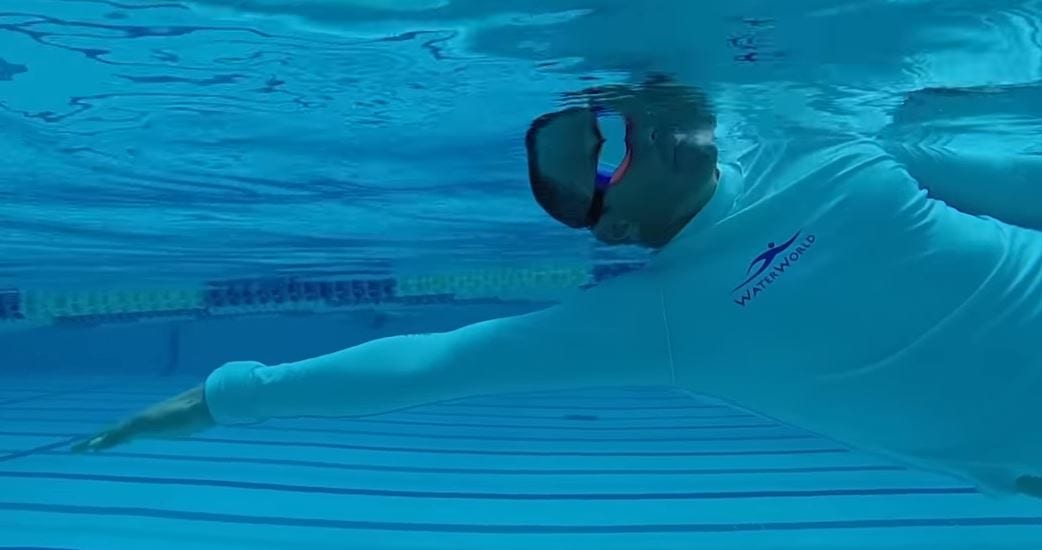How come loosening our lower back while swimming freestyle can help us gain more air and speed?
Most people will say that they feel as though they’re running out of air while they’re swimming, or worse, they feel pain in their lower backs and necks after swimming.
In this video, we will try to understand the difference between the normal freestyle breathing and swim WEST breathing, which was developed in order to loosen and treat lower back pain.
Loosening lower back= swimming much faster
When swimming like Olympic swimmers do, the goal when breathing is to do it as quickly and efficiently as possible to not lose speed and have breathing effect the race. Bob Bowman, Michael Phelps’s coach teaches that the right way to breathe while swimming freestyle is to rotate your whole body sideways to breathe while using your core muscles to do so. But is this really good for you? For non-Olympic swimmers who just want to take a breath without causing pain to their bodies? Is this right for lower back and neck pain? In WEST swimming technique we treat each person as if he or she has a herniated disc even if they don’t luckily suffer from an injury and don’t have pain at all. The idea behind it is that the lower back is the center and the equilibrium of our body and we have to loosen and treat this area of the body constantly! Regardless of whether we suffer from pain there or not. To be even more specific the vertebras we want to loosen are L-2-L3 which are in the lower back.
In this lesson we will learn 5 important tips on how to swim freestyle without hurting your lower back and neck and we’ll also learn the differences between an Olympic swimmer, and the normal swimmer.
- Legs work– Kicking strongly with our legs can extort our lower back while breathing. That’s why in the WEST swimming technique we prefer to loosen our legs and let them be dragged by the upper body that’s working, exactly like a train is being dragged by its locomotive.
- Rotating the body – Olympic swimmers work strongly with their core and take breaths quickly to not waste time in WEST swimming we’re in no hurry and we will try to let the gliding of our hand move the body and rotate so we can breathe .In WEST we will try to breathe when the body is in a 90 degrees angle in order to let the head just slide out of the water without moving and straining the neck at all.
- Timing – Some people say timing is everything! Olympic and flexible swimmers start moving their body for breathing at the end of the pull. But if you’re not as professional or flexible as them you will need to combine the “three powers” together in order for the body to rotate without hearting our neck and lower back, the 3 power being: glide, code and the end of the pull. Exactly as our hand touches the water we will use all three powers together: glide, core & the end of the pull to rotate our body in a 90 degrees angle for the breath and by using all three powers combined and at the same time we won’t need to work hard, and breathing will be very easy and the body will remain loose.
- The depth of the front arm when breathing– Olympic swimmers glide very close to the water line because they can and it’s quicker for them.,
In order to learn normal people’s gliding depth we need to put our hand next to our thigh(this exercise id done our side the water), lower your hand slowly until you feel pressure on your shoulder or neck and that is the exact gliding depth, if you will try to glide closer to the water line your elbow will fall, you will make a stop and shorten your glide which will eventually let you swim slower. - Breathing on both sides, every 3 strokes is very important in order to build up the muscles symmetrically, and not putting all the strain on one side. Our goal in the swim WEST breathing is to do good for our bodies and loosening the neck and lower back while breathing in freestyle is elementary. we are allowed to say “yes” or “No” with the neck and most importantly is to remember to swim according to your own flexibility and not trying to imitate the Olympic swimmer’s flexibility which he worked ferociously to achieve over years of training., By listening to our body’s and working together with it and its flexibly you will eventually gain more air, protect your body and swim much faster in long distances. And your lower back and neck will thank you!
To learn more, to change your body, your breathing without pain in your lower back & neck, join the WEST way to swim.
Start today and get 50% off on your swim WEST freestyle course



